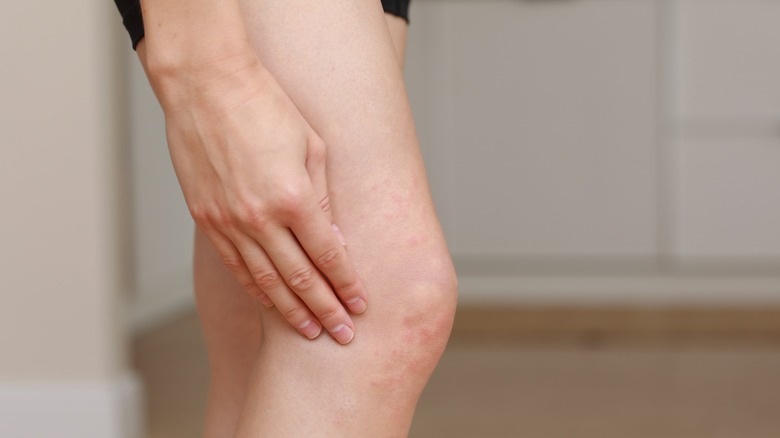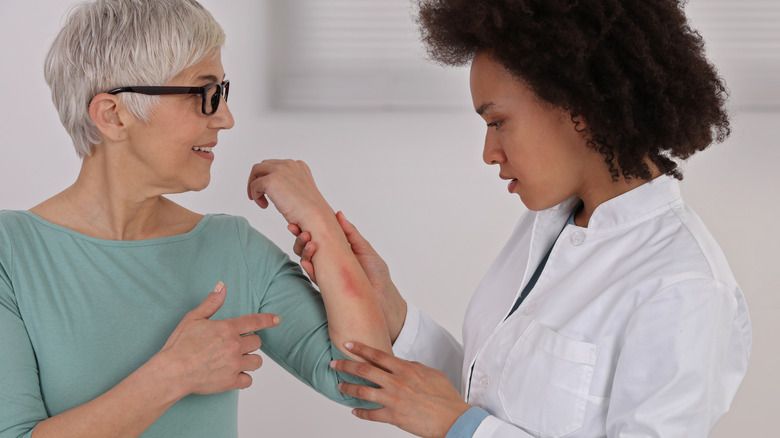What It Really Means If You Get Bumps Or Bleed After Waxing
Waxing is a popular hair removal technique that involves applying a sticky wax to the skin and then pulling it off, along with the hair, in the opposite direction of hair growth. The wax can be made from various materials, including natural beeswax, rosin, and oils (via Healthline). Many people prefer waxing over other hair removal methods as it removes hair from large areas of the body, such as the legs, all at once. Waxing also has longer-lasting results compared to shaving since the hair is removed directly from the roots, reveals the Cleveland Clinic. However, waxing can be painful and cause mild inflammation and sometimes bumps.
If you experience severe or persistent symptoms after waxing, seeking medical attention to rule out any underlying conditions or complications is important. Also, suppose you have any known skin conditions. In that case, it might help to speak to a dermatologist before undergoing waxing or any other hair removal procedures to determine the best approach for your needs.
What causes bumps and bleeding after waxing?
Waxing involves pulling hair out of the skin, which can be traumatic for the hair follicles and surrounding skin. So it's not surprising that bumps or bleeding after waxing are common side effects. There are several potential causes for these types of reactions. Firstly, the trauma caused by waxing can cause inflammation in the skin, leading to folliculitis, says Healthline. This condition is characterized by small, red bumps or pimples that develop around hair follicles. If you notice fluid coming out of the bumps, it might indicate an infection. Aside from the bumps you may encounter, bleeding is common and usually happens when parts of the skin are removed during waxing, especially if you're removing hair from your face (per Healthline).
Another potential cause of bumps or bleeding after waxing is ingrown hair, explains Medical News Today. When hair regrows after waxing, it may become trapped under the skin, leading to inflammation and the formation of itchy and painful bumps, which may become infected. In some cases, bumps after waxing may be caused by an allergic reaction to the wax or other products used during the procedure. This may be due to contact dermatitis, an allergic reactions that can cause burning, swelling, and a stinging sensation.
How can I treat post-waxing bumps?
Overall, bumps or inflammation after waxing are generally mild and should resolve on their own within a few days. In fact, post-waxing bumps can be treated with various methods depending on their severity and underlying cause. For example, mild cases of folliculitis can be treated with over-the-counter topical antibiotics, says the Mayo Clinic. More severe or repeat cases may require prescription-strength antibiotics or antifungal medications, depending on the infection. In cases where bleeding is present after waxing, it should only be a small amount of blood. Be sure to see a doctor if continuous bleeding occurs.
In addition to medical treatment, several self-care measures can help manage your symptoms. For example, one option is to apply warm compresses to the affected area to help reduce inflammation and alleviate discomfort. Additionally, wearing loose-fitting clothing can help reduce friction and irritation on the affected area. Exfoliating regularly but gently can also help prevent post-waxing bumps by removing dead skin cells that can clog hair follicles. If the bumps persist or become more severe, it's best to consult a healthcare provider for further evaluation and treatment.



